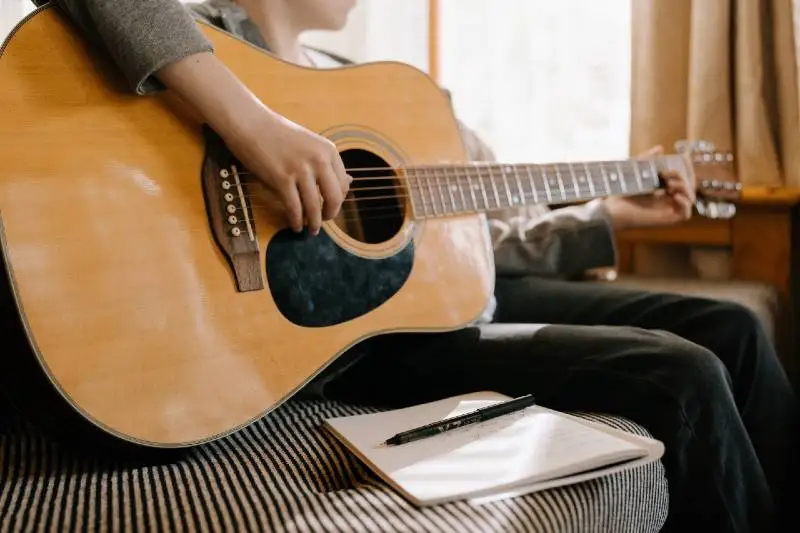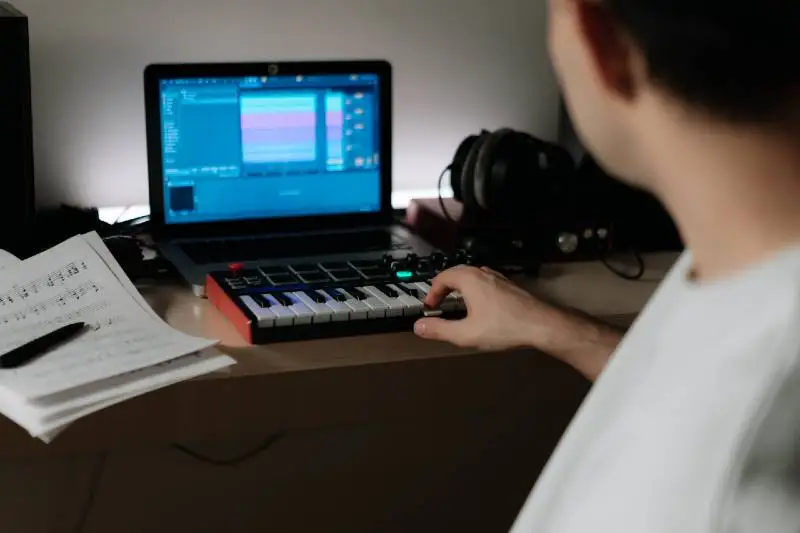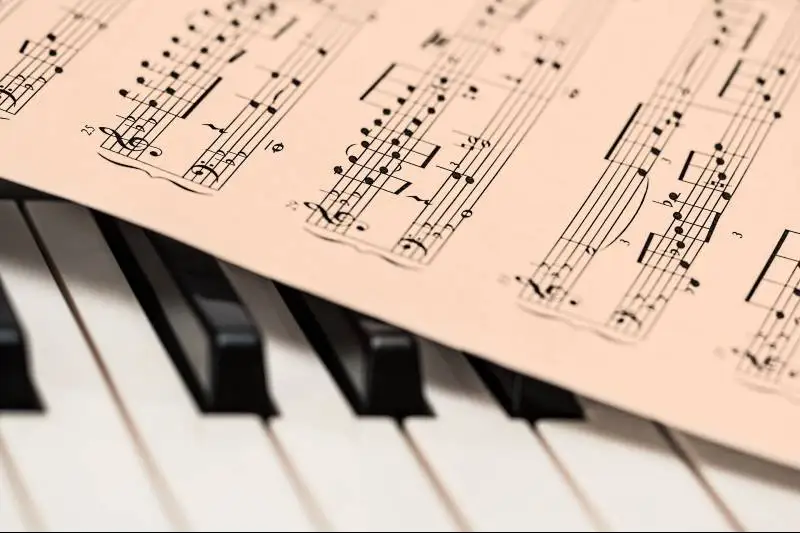Are you ready to start songwriting, but you’re not sure where to start? Learning how to write songs on your own can be daunting, but it's certainly not impossible. With a little bit of guidance and practice, you’ll be able to turn your sparks of inspiration into fully completed compositions.
Below, we’ll discuss how to write a song in 5 easy steps. This step-by-step songwriting guide will walk you through the process of transforming your ideas into standalone tracks, and ties in nicely with previous posts we’ve made about songwriting .
There are plenty of ways to build a catchy song structure, so we'll share more customizable approach. This songwriting process is fully customizable, and will help you build your own songs from the ground up whether you're starting with a chord progression , chorus lyric, or simply your song's mood.
We'll share some of the building blocks of creating your own music along with some songwriting tips so that you can make music that sounds good and connects with others. Learning how to write a song is only a quick read away - Let's get into it!

1. Understand A Song’s Basic Elements
For starters, it can be helpful to understand a song’s essential elements. Generally speaking, you can break these elements down into two groupings: structural and sonic.
You already understand these different pieces intuitively. You could probably identify them by actively listening to your favorite song. Whenever the mood changes or transitions into another section, you’re listening to a shift in the song’s structure. With that in mind, here is the vocabulary you need to categorize these elements.
Structural Elements
These are sections of a song that come together to create an entire piece. Each of these elements serve as building blocks to your overall song structure.
- Verse: Verses in songs usually take up the most time and are usually where the listener gets the most information about the speaker/singer. In lyric-based songs, this is where the singer is telling a story. A repeated chorus usually surrounds the verse. Verses usually aren’t repeated to a T, but they may reuse the same melody as another verse.
- Chorus: These are the shiny, repeated moments in a song. The chorus is usually the most essential part of the song’s melody, and it often fully repeats with the same cadence and melody. Choruses include a hook, which just refers to a phrase or melody designed to stick in your head. The chorus, supported by the verses, is generally shorter and catchier.
- Pre-chorus: A pre-chorus is an additional repeated melodic section that comes unsurprisingly, directly before the chorus.
- Bridge: A bridge just refers to a section that contrasts with the rest of the piece. This could mean a different melodic structure, varied rhythmic pattern, or both. Bridges stand out and can help build tension to a final chorus or going back into a verse.
Some typical song structures include:
- VERSE – CHORUS – VERSE – CHORUS
- INTRO – VERSE – CHORUS – VERSE – BRIDGE – CHORUS
- VERSE – CHORUS – BRIDGE – CHORUS
These are all common patterns, but don't feel like you need to adhere to them in order to be successful. Just remember that every section should add some value for your listener. For example, your second chorus might feel bigger or be longer than your first chorus, even though the sections are more or less copies of one another.
Sonic Elements
These are the main sonic elements you’ll need to consider throughout your writing process.
- Rhythm: The rhythm of your track adds energy and groove to your composition. You’ll want to think about rhythm when determining how each section should flow into the next one. It's key to consider how different melody and verse lyric lines work rhythmically, but you'll also want to consider the rhythm of each sonic element throughout your song.
- Chords and Bass: Chords and basslines serve as a backbone for your melody. These structural elements are usually somewhat repetitive. The repetition allows the melody to stand out against chords or the bass. Chords are created by using notes within the key of your song. If you're not sure how to craft a strong chord progression , you can look up videos or resources online, or simply borrow one from your favorite songs.
- Melody: Melody refers to the string of notes that stands out amongst your other structural elements. Melody can stem through vocals as well as different instruments.
Remember that with any composition, nothing has to be set in stone. Not all songs are structured in the same way or have all of the critical elements represented. That said, these guidelines can be helpful when you’re just starting. They're all helpful songwriting tools and vocabulary you can use to communicate great lyric and melodic ideas with other musicians.
2. Find Something To Start With
Now that you understand the essential elements of a song , it’s time to get started. The best way to get going is to first come up with one of the sonic elements and build from there. Do you have a melody in mind? Record it on voice memos. A sick bassline? Mark it in your DAW . A great beat? Record it and start riffing off of it. Finding inspiration should be a fluid, playful process.
Most of the time, I prefer to start by creating a chord progression. This is often the easiest way for me to get inspired and start building something upon it. Learning basic music theory can be incredibly helpful in your journey as a musician. You can start by looking up common chord progressions online or even using a MIDI chord pack.
From there, improvise with yourself. What can you add to the progression to make it 10% closer to sounding like a full-blown track? During this stage, jot down anything and everything that comes to mind and save it for later.
There’s no one right way to write a song. The key is to create a fundamental element that’s inspiring enough to build off of itself. Here are a couple of examples of how you can build a song from scratch.
Start With The Idea
If you're a natural wordsmith, it may make sense to start with the lyrics . Some songwriters find it helpful to make a brainstorm of their thoughts in order to decide a topic for their song. Once you've selected a topic, you can allow yourself to freely write about the subject at hand.
Some might find it helpful to conceptualize a song by asking a question. For instance, "What makes you feel the most at home?", "How do you feel about X?", "What do you dislike about X?" can all serve as prompts for songs .
You just want to find something that gets your ideas flowing, whether that's a question, brainstorm, or spontaneous start of inspiration. Using your emotional tone while songwriting can naturally help you be more vulnerable towards your audience which is great for bringing in dedicated listeners.
From there, start to formulate your ideas into consistent lines that preferably have some sort of rhyme scheme. Having a full set of lyrics can serve as the pillar for your melody, chords, and the rest of the track. The key concept is to get one portion of the composition concrete so that you're able to have a firm foundation to build off of. Create a lyric sheet for your different ideas.
For songs that are instrumental or without any lyrics, it may be helpful to brainstorm the ideas you're working to convey.
Let's say you're creating a song as part of a score for a movie - It may be helpful to write out different cues, emotions, and points at which you want to shift the track from one sonic idea to the next. Regardless of whether or not your song has lyrics, a little initial planning can go a long way.
Start With An Instrument
While some might only see songwriters as those with guitars or pianos, you can practically build a song off of any sound or instrument. Build a string or notes or a melody and notate it using staff paper.
For a less classical method, you could hum or sing notes into your phone's voice memo app. Experiment with different combinations of notes until a particular string or two seems to stick.
Once you've gained these melodic ideas, you can start to fit rhythm or lyrics to them. In this way, one of the elements of the process should naturally flow into the next.
Start With The Rhythm
If you're more rhythmically inclined, start with building drum or beat ideas. Once you've crafted a couple you're happy with, you can start to improvise on top of them, either with an instrument, sound, or vocal melody. Alternatively, you could piece together a rhythm and figure out the what lyrics make sense within a rhythmic phrase.
As you can see, there are plenty of routes to successful songwriting. All you need to do is to pick which element you'd like to start with, and build from there.

3. Experiment With Melody
Once you’ve created your foundation of the song, it’s time to start adding in melodies . You may find that melodic ideas come to you naturally. Alternatively, you can use a scale to build melodic lines . Create different melodic phrases and capture them in your DAW or voice memos so you can refer back to them later.
Don’t get too hung up on where certain elements will go (i.e., which melody will be for the chorus and the verse). If one seems to fit naturally into one role or the other, that’s great, but remember that you can always refine these ideas later.
One exercise that helps me is playing a chord progression on a loop and improvising melodies using a nonsense word like “da” or “la” on top of it. I’ll record myself singing notes in my voice memos and then add lyrics to these notes later.
If you’re not finding melodies that fit well with your voice or instrument, you can always go a step back and adjust your starting sound.

Refining Your Own Melody
If you already created verse and chorus melodies in the previous step, you can use this section as a time to refine what you've already created. One of the best things about writing songs is that there's no one way to get to your desired destination. Take your loosely formed song ideas and start to edit with a fine ear. Is there a verse melody that shines above the rest? Does your chorus melody run too long or too short? Start to think about these small changes so that you can build a strong song structure through small details.
4. Write Lyrics & Create Structure
Once you have created your melodies, you’re ready to write lyrics . You can use these lyrics to fit within the melodic structure you’ve already created.
Brainstorm different topics you’d like to write about. From there, you can think of words that fit within your melody’s phrasing. It also helps to rhyme lines to give your song some more flow and cohesion.
By this point, you should be able to piece together the whole song. Start laying out where you want your chorus, verse, and bridge sections to be. Feel free to listen to some of your favorite songs and reference their structure. It’s totally fine to listen to a pop song and follow the same format to ensure that yours is organized well.
Once you have structure, lyrics, and melodies that fit solidly together, you can start to rehearse these parts in conjunction with one another.
Building Out Your Song
If you're finding that your song isn't building itself out naturally, you can use a more common song structure, such as an ABAB pattern. These patterns work by having certain sections repeat over the course of a timeline of a song. Each sonic structural element can correspond to a different letter. For example, the verses may be assigned to letter A, the chorus sections to letter B, and the bridge to ABC.
A common pop song structure could be ABABCB. You can look up additional patterns online if you're not sure how to build out your song. If your song doesn't follow a traditional pattern to a T, don't fret! There have been formulaic hit songs but also many of successful songs that don't follow a particular roadmap.
Improving Your Lyrics
For many, it's not difficult learning how to write a song, rather understanding how to write a great song. While creating something that's "good" is somewhat subjective, lyrics play a powerful role in song structure, so you'll want to spend some extra time here while you learn to write songs.
Think about what lyric lines would draw you in as a listener. Does your song title convey something relatable? Is the song title embedded within the chorus lyrics to increase memorability? While this may seem like a small detail, don't forget that a listener's first impression to a track is often the title.
Work on your verse lyric and chorus lyric structure as well. Many hit song writers utilize familiar, relatable concepts in order to connect with their audience. Your entire song should tell a story, or paint a picture for whoever is listening.
You can think of your song structure as having a beginning, middle, and end just like a story. Writing lyrics to the tune of different melodies can be a quick way to see what fits and what doesn't within a common song structure.
While it's important to create a memorable hook , don't use that as an excuse to neglect the song structure of the rest of your track. A compelling first verse can bring a listener in to an otherwise unheard chorus. Writing music is about connecting with others, so make sure your song form supports this and is accessible to a wide variety of people.
Adding Interest
Once you have the basic chord progression, melody, lyrics, and sections ironed out, it's time to add on all of the extra bells and whistles. Fine tune your lyrics to see if there are any general verbs you can replace with more descriptive action words.
This is a great time to add new sounds to your music to keep listeners fully engaged all throughout the track. Your central idea should stay more or less the same at this point, but everything you add on top of the pre-existing music should serve to highlight the best selling points of your track.
Close Out Your Song
First impressions are important, but so is a good ending! Determine how you'd like to end out your track.
For many, this means utilizing one big final chorus that leaves the hook stuck in the listeners head.
For others, this could just be slowly but surely fading out the track.
Think about what makes the most sense for track's emotional and sonic feel. What special lyric can you put in the end of the song that a listener would want to revisit? What makes your track replay-able?
5. Refine Your Track
While you’re practicing your song, you may notice that some lyrics need to be adjusted to flow with the melody or that one section sounds better next to another. Don’t be afraid to edit and refine your track!
It can also help take a step back from your writing session and check back in the next day or week. Sometimes, you need a fresh set of ears to create your best work.
Luckily, with practice, this process should become easier over time. Above all, don’t forget that there isn’t one good way to write a song. Instead, figure out a process that highlights your productivity and creativity.
Don't Be Afraid To Restart
Sometimes, a drafted song can serve as the initial inspiration for your next song. Your first song doesn't have to be perfect. Just remember that if you're having trouble turning a rough idea into a fully formed song, there's nothing wrong with restarting.
You'll want to get into the habit of finishing as many song ideas as you can, but the process of creating a song will inevitably help you hone your skills as a songwriter. Great songs usually come into existence out of plenty of practice, so don't be too hard on yourself if you find that you're stuck on one song.
Get Feedback
One of the best ways to refine your song is to seek out feedback from those you trust. Many times, we become accustomed to the way our songs flow just by nature of working on them for hours on end in a vacuum. Once you feel like you've created a song worth sharing, it's time to see how others feel.
Getting critical feedback can be a sobering process, especially if you're not used to it, but remember that everyone has the end goal in mind of helping you improve your song. Some may find that your song seems to sound good while others may suggest a different chord progression, chorus lyric, etc.
The good news is, you get to decide whether or not you're going to take someone's advice. I recommend seeking out known songwriters and musicians as well as general listeners for feedback. This will give you a more diverse pool of advice, giving you the most potential to improve your song.
If you don't have access to a feedback loop in person, you could ask for it online. Soundcloud, Reddit, etc. all have spaces where you can ask for feedback on a buddy song. Engaging in this practice will help you see the strengths and weaknesses in your own music which will undoubtedly help you grow as an artist and songwriter.
Try, Try Again
Some song writing seems effortless, but a lot of the time there's hours of work and raw material hidden behind that hit song. Your first draft might not always reach it's final song form, and that's okay. Songwriting tips can be helpful , but the best teacher is taking the time to participate in the world of songwriting.
Start writing on a regular basis to really see your songwriting skills come together. Fortunately, your have all of the songwriting tools you need already available - You just have to be brave enough to write many, many songs in order to find that hit.

How To Write A Song FAQs
If you're still unsure of how to write a song, here is a set of commonly asked questions and answers to deepen your understanding about songwriting.
Can Anyone Write A Song?
In short, yes! Anyone can write a song if they are willing to tap into their creativity. Learning to do so isn't always easy, but songwriting is a skill just like anything else, which means that it can be improved over time.
Remember that writing your first set of songs will likely be the most difficult, and become easier over time. With a little practice, writing your own song will seem like second nature.
Is Writing A Song Hard?
The songwriting process can be different every time which means that in some cases, it can be difficult, and in others, it can be effortlessly simple.
Creating your own songs certainly takes practice, but as you exercise the songwriting process on a more regular basis, you'll find that it becomes progressively easier to stumble across a great song. Learning how to write a song can be difficult, but producing a good song can be easy with enough practice.
What Should I Start A Song With?
You should start a song with whatever feels the most natural to you at the time. One of the best parts about songwriting is that it's a fluid process - meaning you don't have to necessarily adhere to one method over another. You could start your song with lyric writing, or begin your session with some killer chord progressions.
Sometimes, it's easiest to have a specific song structure in mind to get the creative juices flowing. Just know that whatever way you choose to write songs is valid, as long as it gets you to write!
How Long Is A Song On Average?
On average, most songs end up being around 3 minutes long. However, plenty of songs are longer or shorter depending on the message, genre, and overall composition.
Rather than focusing on how long a song is, it might be helpful to focus on keeping the listener engaged throughout the duration of your composition.
Can you be a singer without writing songs?
If songwriting isn't necessarily your forte, don't fret! You don't have to be a songwriter in order to be a singer.
In fact, many famous singers don't fully write their songs. Many times, a song is written by multiple songwriters and simply performed by a single singer.
How do you know if a song you wrote is good?
Music, just like any art form, is subjective, so it's impossible to know whether your song is 100% good.
However, if your song is catchy or memorable in some way, listeners may be more likely to listen to it on a regular basis or create an emotional connection to it. This should inform your songwriting, as you should strive to create memorable melodies and relatable lyrics.
Is songwriting a good career?
Songwriting can be a great career for those willing to put in the work. As with most creative industries, it can be quite competitive to find songwriting positions that consistently provide a thriving salary.
Although, if you're willing to hone your craft, it's possible that you'll land a position as a studio songwriter, assisting a wide array of artists on a regular basis.

How long does it take to write a song?
The time it takes to create a song varies greatly depending on your individual composition. It could be within a number of hours, or it could take a number of months.
The important point isn't how long it takes you. It's more productive to focus on whether or not you finished the song. You might find that you become a more efficient songwriter as you practice writing.
How do I check if my song is original?
It's possible that you unintentionally borrowed ideas from other popular songs, so it's a good idea to run your lyrics through a search engine like Google to check for originality. As long as you're crafting your own melodies and lyrics, your song is likely cleared as original. Don't use samples of other songs in your compositions unless you've cleared it from the original artist.
How Do I Start Writing Music?
Writing music can seem daunting, but you should be able to do so if you give yourself the chance to play with your sonic and creative instincts. You can start writing a song based off of an emotion, thought, or even just an imaginary situation.
Songs are more or less melodic stories, so it may be a good idea to write the lyrics first and then add notes after the fact. Once you get one song cleared, writing your second one will be even easier.
What if my song sounds like another song?
Oftentimes, songs sound like one another. If this happens to you, you can always switch up a couple of notes in the melody, or try performing in a different key to build originality. Also note that chord progressions can't be copyrighted, so you're free to utilize the same progression as one of your favorite tracks.
Hopefully, you've come away from this piece with plenty of great ways to write music. Enjoy the creation process and start writing!






